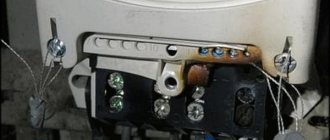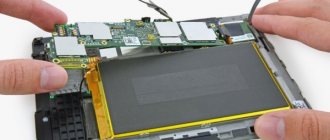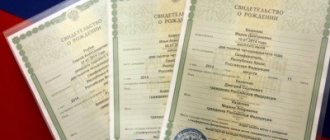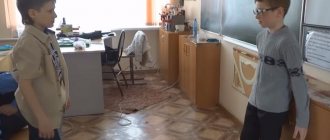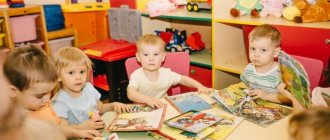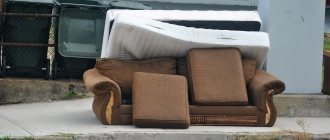When placing their child in the hands of a kindergarten teacher in 200, all parents, and especially mothers, are very worried. How will they take care of their beloved baby? Is there ventilation in the rooms? Does the kindergarten premises meet sanitary and hygienic requirements? At what time intervals are quartzing and general cleaning done? What is the condition of the kindergarten's catering unit, toys, how is the food organized, what is the temperature in the room, table setting (what if the children eat with forks), who is responsible for washing the dishes, etc. I would like to immediately reassure worried parents. The operation of kindergartens in 2020 is impossible without compliance with sanitary and epidemiological requirements.
The environment in the kindergarten must comply with the current standards of SanPiN of the preschool educational institution. You can download them from our website in order to study them carefully. However, this document is quite voluminous in terms of the amount of information. And not every person will be able to understand the nuances of this legislative act.
It is for such situations that experienced online lawyers work on the site. Consultations are absolutely free.
To contact competent specialists, you need to ask your question through the contact form or the pop-up window at the bottom of the site. In addition, in this article we will briefly examine the basic instructions and requirements regarding the maintenance of children in a preschool institution in 2020. Including food, ventilation schedule, cleaning, washing dishes, quarantine standards, processing of vegetables and fruits (eggs, apples, etc.), order.
basic information
What is SanPiN DOU? This is a document that is adopted at the state (federal) level. It contains mandatory sanitary, epidemiological and hygienic standards, rules and requirements. What requirements for kindergartens must be met so that parents can safely leave their children there:
- placement rules;
- technical arrangement of the land plot;
- lighting standards;
- norms for the arrangement of catering facilities;
- sanitary minimum for teachers;
- organization of children's meals;
- compliance of premises with SanPiN 2013 standards for keeping children;
- availability of running water;
- availability of sewerage;
- room temperature and heating standards;
- daily and general cleaning schedule;
- processing of toys;
- quartzing in kindergarten according to SanPiN DOU;
- ventilation and airing standards;
- table setting rules;
- daily regime;
- cleaning and washing dishes;
- number of children in one group;
- the maximum number of children in one group with disabilities;
- standards for hiring employees to work in kindergartens;
- compliance with sanitary requirements, etc.
Kindergartens are different. Both in terms of age and mode of operation. Most often, kindergartens combine several areas of work. So, what types of preschool institutions are there:
- for small children;
- for preschoolers of middle and older ages;
- health-improving children's institutions;
- specialized kindergartens;
- narrowly focused preschool institutions for children (for example, with a mathematical bias);
- kindergartens for children with disabilities or mental disabilities, etc.
Preschool institutions for children that combine several areas are called combined. Regardless of the profile of the kindergarten, all necessary sanitary, epidemiological and hygienic standards and rules must be complied with.
I work as a cook for 300 children in a kindergarten
timely provision of technical and other documentation necessary for work;
working conditions that meet labor protection and production safety requirements. proper quality of materials, tools, other means and items necessary to perform the work, their timely provision to the employee;
They said I couldn’t bear it, I went on sick leave. I want to know how many cooks there should be for 300 children.
An attempt to establish standards for the number of kitchen workers, including cooks, was made in 1985: Guidelines for organizing rational nutrition for students in secondary schools were approved by Order of the USSR Ministry of Trade dated December 26, 1985 N 315. This document contains in Appendix No. 5 the Approximate number of workers in single-shift canteens at secondary schools.
Read other lawyers' answers:
- How to Remove and Register a Car
- What is considered Refurbishment in Communal Apartments
- How to De-Register at the Speed Center
- How much do they pay for a Privatized Apartment?
- How to Return Household Appliances to the Store
Dear colleagues, I wish each of us to hold high the title of lawyer, unswervingly adhering to the principles of impartiality and objectivity!
Requirements for catering
Very often we hear about cases of poisoning of children in kindergartens. In such cases, an investigation is carried out and the perpetrators of the incident are identified. Often they become catering department employees who do not fully comply with the sanitary minimum requirements according to SanPiN. With regard to products for feeding children, it is imperative to comply with all the requirements of SanPiN 2013.
We will now list some of them:
- all products must be fresh, in compliance with storage rules, and have supporting documents from the supplier;
- storage of perishable food products must be organized in accordance with the instructions;
- food products must be stored in original or consumer containers, covered with a lid if necessary;
- bakery products are stored on dry shelves or racks no lower than 35 centimeters from the floor;
- pasta must be kept in a dry, ventilated area in compliance with the requirements of SanPiN for preschool educational institutions;
- There are also rules for storing and processing potatoes and root vegetables that must be followed exactly before they reach the children’s table, etc.
In general, the list of requirements is quite large. It can be found in more detail in Chapter 14 of the 2013 SanPiN standards for kindergartens. As an example, we can consider the procedure for processing eggs for feeding children. Before cooking eggs, they must be soaked in a special container in a disinfectant solution. Then rinse under warm running water and transfer to another container. Where they will be stored until cooking. Cooking the eggs continues for ten to fifteen minutes.
Food department
Also, each group for children should be equipped with a dishwasher with not only cold water, but also hot water. Children need to wash dishes correctly, following the processing order:
- cleaning up food debris;
- washing with soda and mustard;
- washing with bleach;
- rinsing dishes;
- daily treatment in boiling water;
- drying on special racks.
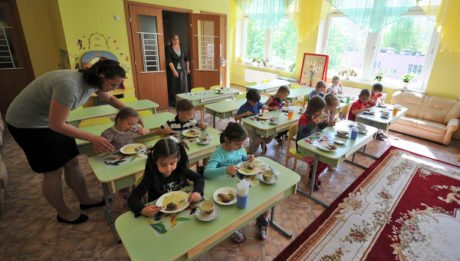
The catering unit, including the common kitchen and rooms in groups, must be kept perfectly clean. It should be cleaned on a schedule and if necessary. Vitamins are added to food only with parental consent and under the supervision of a health professional, not a teacher. All utensils must be labeled. A separate container is provided for each dish. If you have any questions, you can contact the specialists on the site.
Memo for the teacher "SanPiN"
Ainura Maharramova
Memo for the teacher "SanPiN"
The toilet provides a place for preparing disinfectant solutions.
4.32. Meals for children are provided in a group setting. Delivery of food from the catering unit to the group one is carried out in specially designated, marked, closed containers. Labeling must indicate the group affiliation and type of dish (first, second, third)
.
4.33. In preschool educational organizations, for washing tableware, the pantry is equipped with two-cavity washing baths with cold and hot water supply to them. With a decentralized water supply, the pantry is provided with containers for washing dishes.
It is allowed to equip a sanitary facility for staff in the children's toilet in the form of a separate closed toilet cubicle.
The children's toilet should be provided with personal potties for each child actually in the group, preschool educational organization,
5.5. For the floor, materials are used that can be processed wet, using washing and disinfecting solutions.
Wardrobes for clothes and shoes are equipped with individual compartments - shelves for hats and hooks for outerwear. Each individual cell is labeled.
In dressing rooms (or in separate rooms)
Conditions must be provided for drying children's outerwear and shoes.
In the vestibules of newly constructed facilities of preschool educational organizations, it is allowed to install racks for toys used during walks.
6.6. Chairs and tables must be from the same furniture group and labeled.
6.10. Preschool educational organizations use toys that are harmless to children’s health, meet sanitary and epidemiological requirements and have documents confirming safety, which can be wet processed (washed)
and disinfection. Soft-fill and foam latex brushed toys for preschool children should be used only as teaching aids.
6.13. In existing preschool educational organizations, if there are no bedrooms according to the project or there is insufficient area of available sleeping quarters, it is allowed to organize daytime sleep for children of preschool groups in groups on folding beds with a hard bed or on transformable ones (pull-out, roll-out)
one - three-level beds.
6.15. Children are provided with individual bedding, towels, and personal hygiene items. You should have at least 3 sets of bed linen and towels, 2 sets of mattress covers per 1 child. Bed linen is marked individually for each child.
6.16.1. A toilet room for young children is equipped in one room, where there are 3 washbasins with hot and cold water supply for children, 1 washbasin for staff, a cabinet (rack)
with cells for storing individual pots and a drain for processing them, a children's bath, a utility closet. Pots must be labeled.
In the toilets, hot and cold water supply is provided to the washbasins; water is supplied through a mixer.
6.20. For preschool staff, it is recommended to organize a separate sanitary room on each floor of the building of a preschool educational organization with a toilet and washbasin.
6.21. In toilet areas (next to or opposite washbasins)
Hangers for children's towels
(separately for hands and feet)
according to the list of children, a utility closet and a closet for cleaning equipment. Disposable hand towels are permitted in children's restrooms.
It is allowed to install cabinets for cleaning equipment outside the toilet rooms.
8.2. The use of portable heating devices, as well as heaters with infrared radiation, is not allowed.
8.3. Enclosing devices of heating devices must be made of materials that do not have a harmful effect on humans.
Fences made of particle boards are not used.
Through ventilation is carried out for at least 10 minutes every 1.5 hours. In group rooms and bedrooms in all climatic regions, except for IA, 1B, 1G climatic subdistricts, natural cross or corner ventilation should be provided. Ventilation through toilet rooms is not allowed.
In the presence of children, wide one-sided aeration of all rooms is allowed in the warm season.
8.6. The duration of ventilation depends on the outside temperature, wind direction, and the efficiency of the heating system. Airing is carried out in the absence of children and ends 30 minutes before they arrive from a walk or activity.
When ventilating, a short-term decrease in the air temperature in the room is allowed, but not more than 2 - 4°C.
In the bedrooms, cross-ventilation is carried out before daytime sleep.
When ventilating the transoms and vents while sleeping, they open on one side and close 30 minutes before rising.
In the cold season, transoms and vents are closed 10 minutes before children go to bed.
In the warm season, sleep (day and night)
organized with open windows
(avoiding drafts)
.
8.7. The values of air temperature and indoor air exchange rate per hour must be taken in accordance with the requirements for air temperature and air exchange rate in the main premises of preschool educational organizations in different climatic regions (Appendix No. 3)
.
8.9. Air temperature control in all main rooms where children stay is carried out using household thermometers. (Where)
11.1. Admission of children entering preschool educational organizations for the first time is carried out on the basis of a medical report.
11.2. Daily morning reception of children is carried out by teachers and (or)
medical workers who interview parents about the health status of their children.
According to indications (in the presence of catarrhal phenomena, signs of intoxication),
the child is subjected to thermometry.
Identified sick children or children with suspected illness are not accepted into pre-school educational organizations; Children who fall ill during the day are isolated from healthy children (temporarily placed in the medical unit)
before the arrival of parents or their hospitalization in a treatment and prevention organization, informing the parents.
11.3. After an illness, as well as absence for more than 5 days (except weekends and holidays)
Children are admitted to preschool educational organizations only if they have a certificate indicating the diagnosis, duration of the disease, and information about the lack of contact with infectious patients.
11.5. The recommended duration of daily walks is 3-4 hours. The duration of the walk is determined by the preschool educational organization depending on climatic conditions. When the air temperature is below minus 15°C and the wind speed is more than 7 m/s, it is recommended to reduce the duration of the walk.
11.6. It is recommended to organize walks 2 times a day: in the first half of the day and in the second half of the day - after a nap or before the children go home.
The total duration of daily sleep for preschool children is 12 - 12.5 hours, of which 2 - 2.5 hours are allocated for daytime sleep. For children from 1 year to 1.5 years, daytime sleep is organized twice in the first and second half of the day for a total duration of up to 3.5 hours. It is optimal to organize daytime sleep outdoors (veranda)
.
For children from 1.5 to 3 years old, daytime sleep is organized once for at least 3 hours. Before going to bed, it is not recommended to conduct active emotional games or hardening procedures. When children sleep, the presence of a teacher (or his assistant)
in the bedroom is mandatory.
11.9. For young children from 1.5 to 3 years old, the duration of continuous direct educational activity should not exceed 10 minutes. It is allowed to carry out educational activities in the first and second half of the day (8-10 minutes each)
. It is allowed to carry out educational activities on the playground during a walk.
11.13. Educational activities that require increased cognitive activity and mental stress of children should be organized in the first half of the day. To prevent children from becoming tired, it is recommended to conduct physical education, music, rhythm classes, etc.
12.4. For children of the second and third year of life, classes on physical development of the main educational program are carried out in subgroups 2-3 times a week. With children of the second year of life, classes on physical development of the main educational program are carried out in a group room, with children of the third year of life - in a group room or in a gym.
The recommended number of children in a group for physical development classes and its duration, depending on the age of the children, is presented in Table 2.
12.6. Hardening children includes a set of activities: extensive aeration of the premises, properly organized walks, physical exercises carried out in light sportswear indoors and outdoors, washing with cool water and other water, air and solar procedures.
12.10. To achieve a sufficient volume of physical activity in children, it is necessary to use all organized forms of physical exercise with a wide inclusion of outdoor games and sports exercises.
Work on physical development is carried out taking into account the health of children with constant monitoring by medical workers.
17.1. All rooms are cleaned using a wet method using detergents at least 2 times a day with open transoms or windows, with mandatory cleaning of places where dust accumulates (floors near baseboards and under furniture, window sills, radiators, etc.)
and frequently dirty surfaces
(door handles, cabinets, switches, hard furniture, etc.)
.
Wet cleaning in bedrooms is carried out after night and daytime sleep, in group rooms - after each meal.
17.2. Tables in group rooms are washed with hot water and soap before and after each meal with a special rag, which is washed, dried and stored dry in a special labeled container with a lid.
Chairs, changing tables, playpens and other equipment, as well as oilcloth linings and oilcloth bibs, are washed with hot water and soap after use; fabric bibs are washable.
Toys are washed in specially designated, marked containers.
17.3. For technical purposes (cleaning group rooms, toilets, etc.)
A separate water tap will be installed in group toilet rooms.
17.4. Carpets are vacuumed daily and cleaned with a damp brush or knocked out in specially designated areas in the utility area, then cleaned with a damp brush. It is recommended to dry clean carpets once a year.
17.5. Sanitary equipment is disinfected daily, regardless of the epidemiological situation. Toilet seats, flush tank handles and door handles are washed with warm water and soap or another detergent that is harmless to human health every day. Pots are washed after each use using ruffs or brushes and detergents. Bathtubs, sinks, and toilets are cleaned twice a day with ruffs or brushes using detergents and disinfectants.
17.6. General cleaning of all premises and equipment is carried out once a month using detergents and disinfectants. Windows outside and inside are washed as they become dirty, but at least 2 times a year (spring and autumn)
.
17.7. In case of an unfavorable epidemiological situation in preschool educational organizations (groups), in order to prevent the spread of infection, additional measures are taken in accordance with the requirements of sanitary rules.
When cases of infectious diseases are registered, anti-epidemic measures are carried out by the staff of the preschool educational organization.
17.8. In case of an unfavorable epidemiological situation in preschool educational organizations (groups), in order to prevent the spread of infection, additional measures are taken in accordance with the requirements of sanitary rules.
When registering cases of infectious diseases, sanitary and anti-epidemic (preventive)
activities in accordance with the sanitary legislation of the Russian Federation.
17.9. In the warm season, windows and doors are screened. To combat flies indoors, it is allowed to use mechanical methods (sticky tapes, fly traps)
.
17.10. The louvers of exhaust ventilation systems must be open; They should be covered only when there is a sharp difference in indoor and outdoor air temperatures. As they become dirty, they are cleaned of dust.
Exhaust ventilation shafts are cleaned as soon as they become dirty.
17.11. All types of repair work are not allowed to be carried out during the functioning of preschool educational organizations in the presence of children.
17.12. Purchased toys (excluding stuffed ones)
Before entering group classes, they are washed with running water
(temperature 37°C)
with soap or other detergent that is harmless to the health of children, and then dried in air.
Foam latex tufted toys and soft stuffed toys are processed according to the manufacturer's instructions.
Toys that are not subject to wet processing (washing, laundering) are used only as teaching material.
17.13. Toys are washed daily at the end of the day, and in groups for infants and young children - 2 times a day. Doll clothes are washed when dirty using baby soap and ironed.
17.14. Bed linen and towels are changed when soiled, but at least once a week. All linen is marked.
Bed linen, except pillowcases, is marked at the foot edge. Each child must have three sets of linen, including face and foot towels, and two changes of mattress covers. Clean linen is delivered in bags and stored in closets.
17.15. After use, the laundry is placed in a special tank, a bucket with a lid, an oilcloth, plastic or double cloth bag. Dirty laundry is delivered to the laundry room (or special room)
. Cloth bags are washed, oilcloth and plastic bags are treated with a hot soap-soda solution.
17.16. Bedding: mattresses, pillows, sleeping bags are ventilated directly in the bedrooms with the windows open during each general cleaning and periodically in specially designated areas of the utility area. It is recommended that bedding be dry cleaned or treated in a disinfection chamber once a year.
17.17. Sponges for washing children (the number of washcloths corresponds to the number of children in the group)
after use, soak in a disinfectant solution, wash with running water, dry and store in clean cloth bags.
17.18. Preschool educational organizations must take measures to prevent the entry of insects and rodents. If they are detected, disinsection and deratization measures must be organized and carried out within 24 hours in accordance with the requirements for disinfection and deratization measures.
19.6. Teachers and assistant teachers are provided with special clothing (light-colored dressing gowns)
.
19.7. Before entering the toilet room, staff must take off their robe and wash their hands thoroughly with soap after exiting; employees are not allowed to use the children's toilet.
19.8. The assistant teacher must additionally have: an apron, a cap or scarf for serving food, an apron for washing dishes and a special (dark)
cleaning robe.
Children's quarantine
Quarantine in kindergarten is a separate issue. Each parent is concerned about the health of their child. The duration of quarantine in kindergarten depends on the type of disease. The announcement of quarantine also depends on what illness the students have. For example, to close a kindergarten due to the flu, twenty percent of the children need to get sick. In other situations, one case of illness is enough. The duration of quarantine ranges from seven to twenty-one days. Parents are required to be notified on the day of diagnosis. And also about the possibility of illness (that is, suspicion of illness). It is not necessary that a preschool institution be closed during quarantine. It is possible to simply limit the contacts of sick children with groups where there are no sick people. That is, healthy students are not allowed to go for walks in the common yard or are not taken to the gym where sick children may be present. And the kids eat in their group, which should have its own catering unit.
You cannot take your children to a preschool during quarantine if you are firmly convinced that your child has not had contact with sick people. In other cases there are no restrictions, everything is at the discretion of the parents.
For example, some mothers and fathers believe that the sooner a child gets chickenpox, the better. At the same time, it is necessary to limit your child’s contact, if he is sick, with healthy children. The teacher’s guilt in the spread of diseases in groups of preschool institutions is usually minimal if he has fulfilled all the sanitary and hygienic requirements established in such situations. Namely, the sanitary minimum for a teacher.
Kindergarten cooks
It's up to you to decide whether to accept the employer's offer or not. Do not take vacation at your own expense since downtime is subject to payment.
You have the right to disagree. You must be paid for downtime due to the employer’s fault in the amount of 2/3 of your average earnings. According to Article 157 of the Labor Code of the Russian Federation, downtime (Article 72.2 of the Labor Code of the Russian Federation) due to the fault of the employer is paid in the amount of at least two-thirds of the employee’s average salary. In this case, it is the employer's fault. And according to Article 72, 72.2 of the Labor Code of the Russian Federation, you are not obliged to agree to change the terms of the employment contract and work at a low-paid rate.
It is not so easy to hold a financially responsible person liable. An inventory must be taken, then the reasons for the shortage must be identified. After which the MOL may agree to compensate for the shortfall voluntarily or through the courts. Persons with whom an agreement on full financial liability has not been concluded can be held liable only in the event of direct actual damage to the employer as a result of intentional actions.
By agreement of the parties, concluded in writing, an employee may be temporarily transferred to another job with the same employer for a period of up to one year, and in the case where such a transfer is carried out to replace a temporarily absent employee, whose place of work is retained in accordance with the law , - before this employee goes to work. If, at the end of the transfer period, the employee’s previous job is not provided, and he did not demand its provision and continues to work, then the condition of the agreement on the temporary nature of the transfer loses force and the transfer is considered permanent.
For 170 children there must be at least 6 kitchen workers. In preschool institutions with 3 or more nursery groups or groups with children staying around the clock, an additional 0.5 cook position units are established.
SanPiN for preschool educational institutions with changes for 2020
» The upbringing and maintenance of minors in kindergartens cannot be left to chance.
Sanpin for kindergartens includes a complete list of requirements for preschool education organizations: requirements for the placement of preschool educational institutions; conditions of maintenance and equipment of the territory; maintenance and equipment of internal premises; room lighting (natural and artificial); rules for the provision, equipment and repair of ventilation, heating, water supply and sewerage; conditions for preparing and serving food; admission of minors to the group;
Who washes toys in a dhow according to sanpin
quoted1 > > The upbringing and maintenance of minors in kindergartens cannot be left to chance.
Taking this into account, the legislator has developed a set of detailed rules that are mandatory for all preschool organizations. The document includes requirements for the premises, regime of pupils and staff. SanPin 2.4.1. 3049-13 are sanitary and epidemiological requirements for preschool educational institutions.
Sanpin for kindergartens includes a complete list of requirements for preschool education organizations: requirements for the placement of preschool educational institutions; conditions of maintenance and equipment of the territory; maintenance and equipment of internal premises; room lighting (natural and artificial); rules for the provision, equipment and repair of ventilation, heating, water supply and sewerage; conditions for preparing and serving food;
We recommend reading: How much is the permissible clearance of tinting on front windows?
